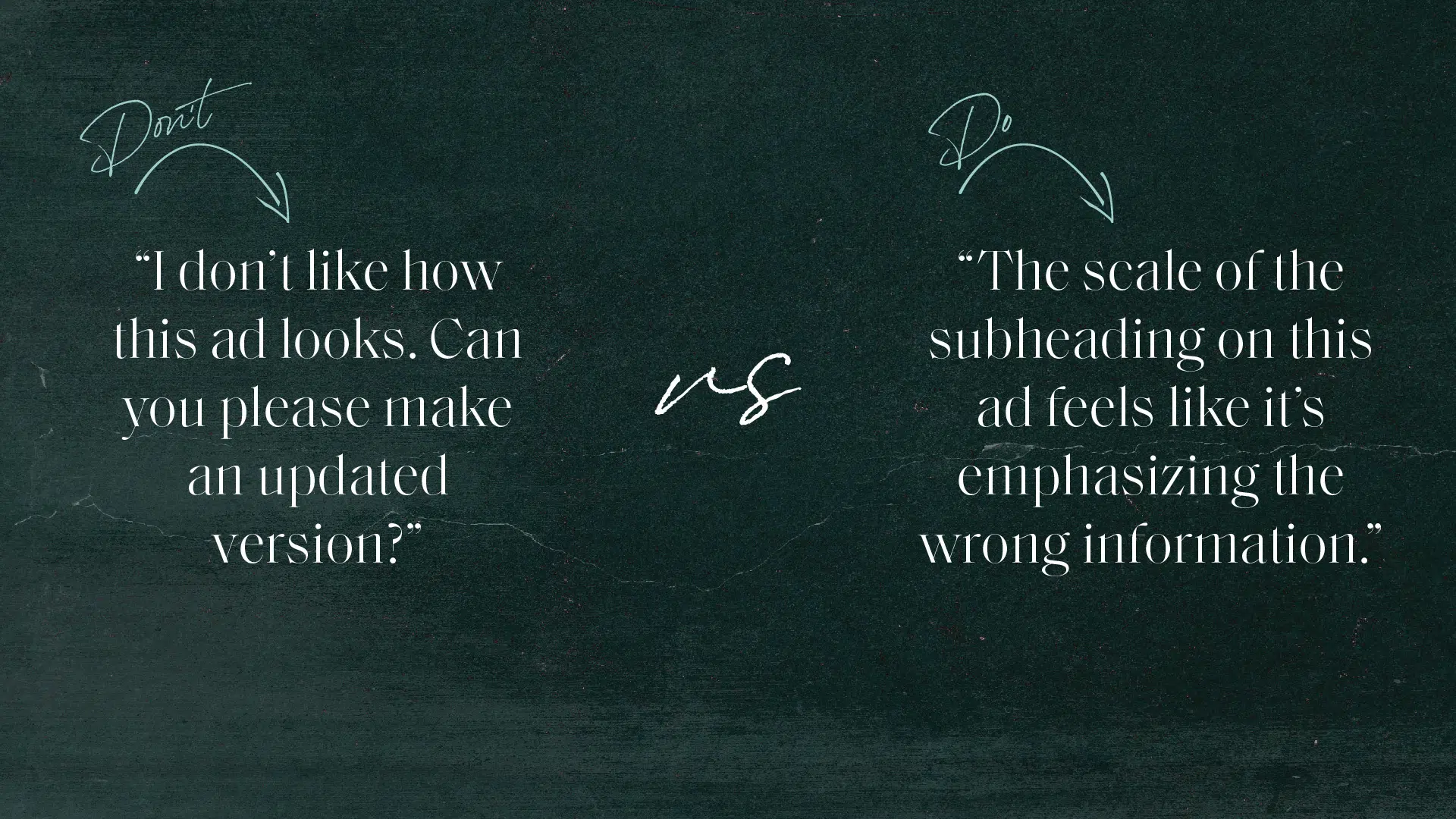Revisions and feedback are as essential to sticking the landing with any creative assets that go out the door — whether you’re a sales leader reviewing collateral for your next trade show or a marketing director working with a vendor on ad assets, videos, website adjustments, or any other creative medium. That said, there are productive and counterproductive ways to go about delivering feedback to the individuals responsible for bringing a creative vision to life. It seems simple enough — share your thoughts and opinions regarding why revisions need made. However, if your goal is to see true improvement in what you’re reviewing, there’s much more to consider. Both you — the reviewer of the work — and the creatives who made it hold accountability in this process.
So, think back on a time you’ve received or given feedback. You may have used a tool such as the well known feedback sandwich — the process of “sandwiching” your constructive criticism between moments of positive feedback. This is a method of the past that can create a lack of clarity — limiting the recipient of that feedback’s ability to fix what you’re actually looking to solve. If you’re looking to refine how you not only receive feedback, but how you interpret and implement it, check out these five tips.
Be Clear
A common best practice — in this scenario and at large — is to never give or accept fuzzy assignments. If your feedback is vague, and your partner accepts it at face value, you are both already set up for failure. Let’s envision a theoretical scenario of you, the leader of an internal marketing team, reviewing a proposed new color palette for your upcoming product with your agency partner. A comment such as “I don’t like this color palette” or “can you try a different primary blue?” exemplifies the type of counterproductive feedback we want to avoid. Something clearly isn’t quite right from your perspective, but this statement doesn’t explicitly identify the problem that you see — preventing the team from taking action on that feedback.
Let’s say, instead, your feedback was along the lines of “I’d like to use a different color palette. Multiple of our competitors use a similar shade of blue and I believe we should differentiate ourselves by using another color to stand out” — which clearly addresses the thought-process behind your feedback and better aligns expectations for what needs to change. Setting aside the fact that your partner should have conducted better competitive research in this scenario, they can now ask better-informed questions about where to head next. Feedback should always have a purpose. The clearer, the better. Afterall, the point of this process at large is to achieve a result both you and your partner are proud of.
Be Considerate
Emotional intelligence and empathy are — or at least should be — workplace staples. Your partner has poured time, effort, and resources into their recommendation. It’s important to keep in mind you’re critiquing the work, not the person. Choose words carefully. In order for your commentary to be well received, keep it judgment free and focused on the task at hand — bringing something to market that resonates with your audience. As you’re reviewing what your vendor or marketing partner has brought to table, you should not only consider your personal perspective as brand steward for your organization, but what would your target audience think? Place yourself in their shoes. Does it evoke the desired emotional response? Does it drive the consumer to take action? Is it thought-provoking?
As you sort through your initial thoughts, take that moment to recognize you may not be the target audience and filter your feedback according to the primary audience for this work.
Maintain a Dialogue
Think about the last time you were the recipient of pushback around an idea or direction you established; did you want the opportunity to explain your reasoning and ask questions, or simply take that feedback as it stands? A huge mistake in the feedback process is not inviting a response. Communication is a two-way street. Strong professional relationships are based on trust and honesty — the first step in fostering this is to allow the conversation to flow.
Pause after you’ve shared thoughts and invite the other party to share their own input and interpretation of your feedback. Once you’ve had a true conversation, aligning on how to proceed, you’re far more likely to receive an updated version that reflects what you actually want to see. This give-and-take method of feedback also applies to alignment at the beginning of the work. Circling back to the “fuzzy assignments” comment above, the more questions you ask each other at the outset of a project, the less feedback you’ll need to manage along the way.
Be Timely
When’s the best time to provide feedback? The sooner, the better. As you notice a misalignment with your expectations, address it now so that the issue doesn’t fester and cause delays in the work. Waiting only delays timelines and can create frustration. If you have enough clarity in the moment of reviewing the work to provide feedback that aligns with the three tips above, great — do so. If you need time to process and think through what doesn’t exactly resonate — make sure you and your vendor align on when they can expect your thoughts. It’s somewhat like exercise — the best time to start is yesterday and the second best time is right now.
Don’t Forget to Recap
This one’s fairly simple. Before closing out a meeting, recap what was discussed and what next steps are for you and your partner. In doing so, you’ll catch any misunderstandings that slipped through the cracks. Both parties involved should leave the conversation feeling clear on what was not working, where exactly to make changes, and a set date for the next check-in. Feedback isn’t a one and done situation; it’s a continual process until everyone feels they’ve reached the final goal.
Negative feedback and constructive criticism sometimes get a bad wrap, but they are a necessary part of the creative process. When the conversations are had in the right way, there need not be any discomfort or awkward feelings. You are marching in the same direction, working towards the same goals. Know that. A final point to remember is that feedback doesn’t have to be negative. Positive reinforcement is equally as valuable in development and review of your team’s work. Whether it be constructive criticism or affirmation, make your feedback meaningful.





